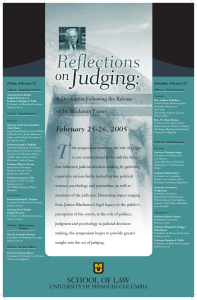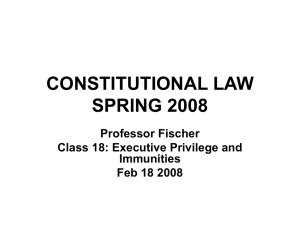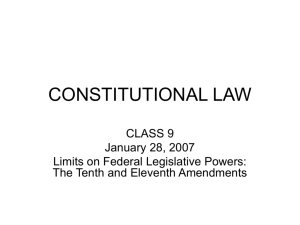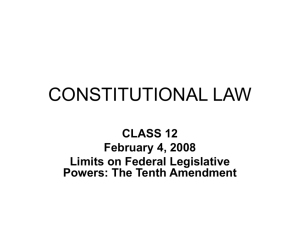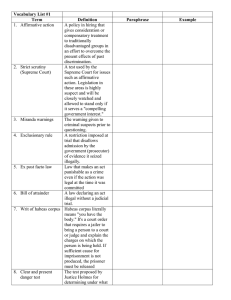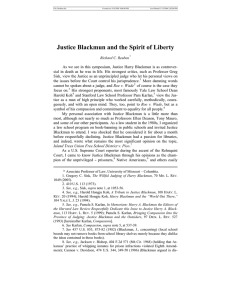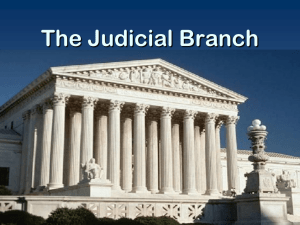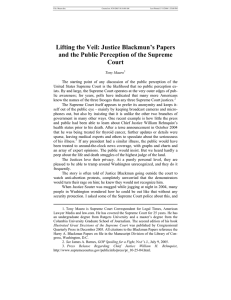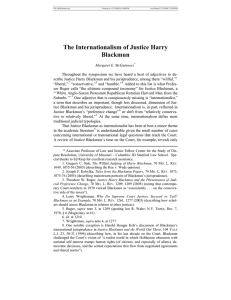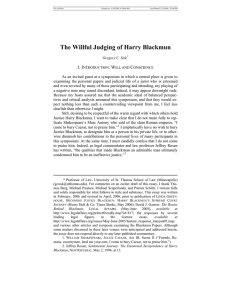MISSOURI LAW REVIEW Symposium Reflections on Judging: A Discussion
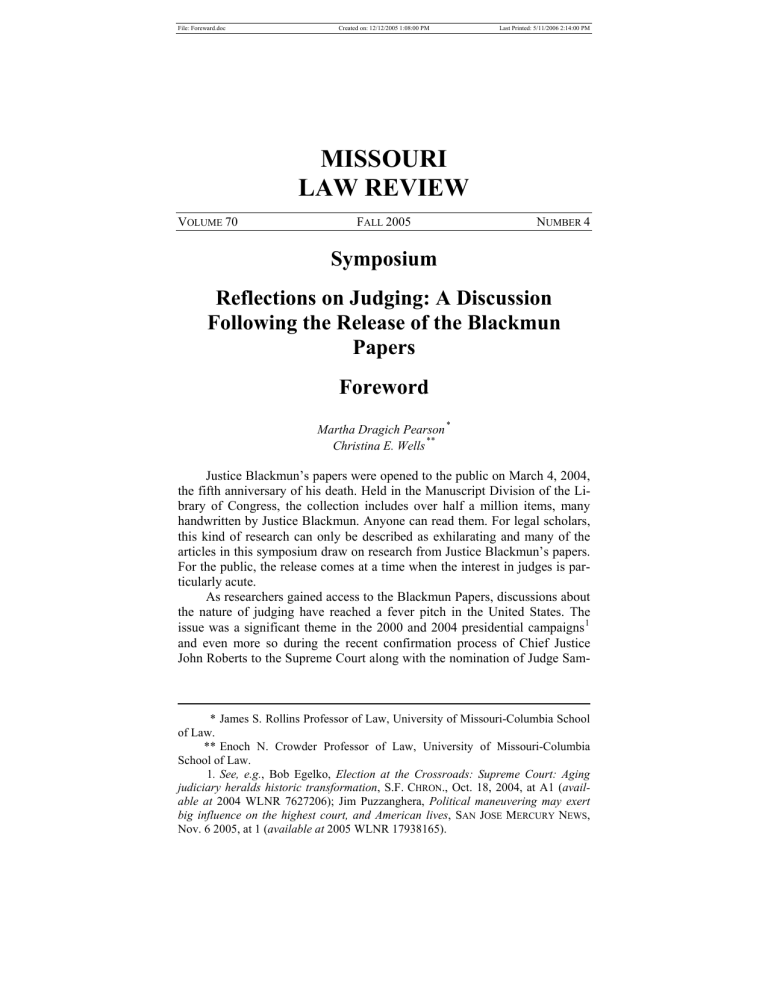
File: Foreward.doc Created on: 12/12/2005 1:08:00 PM Last Printed: 5/11/2006 2:14:00 PM
MISSOURI
LAW REVIEW
V OLUME 70 F ALL 2005 N UMBER 4
Symposium
Reflections on Judging: A Discussion
Following the Release of the Blackmun
Papers
Foreword
Martha Dragich Pearson
Christina E. Wells
Justice Blackmun’s papers were opened to the public on March 4, 2004, the fifth anniversary of his death. Held in the Manuscript Division of the Library of Congress, the collection includes over half a million items, many handwritten by Justice Blackmun. Anyone can read them. For legal scholars, this kind of research can only be described as exhilarating and many of the articles in this symposium draw on research from Justice Blackmun’s papers.
For the public, the release comes at a time when the interest in judges is particularly acute.
As researchers gained access to the Blackmun Papers, discussions about the nature of judging have reached a fever pitch in the United States. The issue was a significant theme in the 2000 and 2004 presidential campaigns
and even more so during the recent confirmation process of Chief Justice
John Roberts to the Supreme Court along with the nomination of Judge Samof Law.
School of Law.
1 . See, e.g.
, Bob Egelko, Election at the Crossroads: Supreme Court: Aging judiciary heralds historic transformation , S.F.
C HRON ., Oct. 18, 2004, at A1 ( available at 2004 WLNR 7627206); Jim Puzzanghera, Political maneuvering may exert big influence on the highest court, and American lives , S AN J OSE M ERCURY N EWS ,
Nov. 6 2005, at 1 ( available at 2005 WLNR 17938165).
File: Foreward.doc Created on: 12/12/2005 1:08:00 PM Last Printed: 5/11/2006 2:14:00 PM
966 MISSOURI LAW REVIEW [Vol. uel Alito and the failed nomination of Harriet Miers.
As Congress, the media, and legal scholars debated the wisdom and merits of the nominees, much of their discussion centered on what makes a good (or bad) judge and how particular nominees would perform in that role.
Such debates have also dominated the appointment of judges to the lower federal courts for years. As many of the symposium contributors reveal, Justice Blackmun’s own judicial legacy is hotly debated.
These debates expose a dilemma: We want to know (or to be able to predict) how judges will decide cases we care about. We want to know what shapes a judge’s approach to a case. Thus, judicial nominees in confirmation hearings are asked about their judicial philosophies and their views of current issues or past decisions. But we also insist that judges decide cases according to law, putting aside the personal convictions that were probed during the confirmation process. Once confirmed, judges can retreat behind the court’s mantle of secrecy. Even the most astute reader of opinions can have a hard time piecing together after the fact what made a judge vote or write as she did, why a judge changed her mind on an issue, or what moved the court in one direction or another. Enormously controversial decisions, such as Roe v. Wade
or Bush v. Gore ,
arouse skepticism that judging is anything more than raw politics.
The Blackmun Papers reveal this dilemma in operation. Because the Papers are unusually extensive and because many of the members of the present
Supreme Court served with Justice Blackmun, the Papers reveal much about the current Court. Not surprisingly, the release of the Papers was quite controversial. And that controversy seems to turn, in part, on disagreements about how much we should know about what goes on at the Court, an institution long shrouded in secrecy and confidentiality.
Some students of the Court argue that the release of the Papers is a positive step. Harold Koh, Dean of the Yale Law School and a former Blackmun clerk, for example, notes that the Papers provide an “authoritative archive of
2. Trying to judge the mind of Alito, Questions to probe Supreme
Court pick , S TAR -L EDGER (N EWARK ), Nov. 4, 2005, at 1 ( available at 2005 WLNR
17860522).
3 . See, e.g.
, Sheryl Gay Stolberg, Panel Approves Roberts, 13-5, As 3 of 8 Democrats Back Him , N.Y.
T IMES , Sept., 23, 2005, at A1; Matt Stearns, “The type of nominee I’ve been asking for” , K.C.
S TAR , Nov. 9, 2005, at A3; John H. Reese, Questions for high court nominee , D ENVER P OST , Nov. 6, 2005, at E1.
6. , Vincent Bugliosi, None Dare Call It Treason , T HE N ATION , Feb. 5,
2001 (characterizing the Supreme Court in Bush v. Gore as having “committed the unpardonable sin of being a knowing surrogate for the Republican Party instead of being an impartial arbiter of the law”) ( available at http://www.thenation.com/ doc/20010205/bugliosi); Ronald Dworkin, The Great Abortion Case , N.Y.
R EV .
B OOKS , June 29, 1989, at 53 (arguing that Court’s abortion decisions engender a
“cynical view . . . that constitutional law is only a matter of which president appointed the last few justices”).
File: Foreward.doc Created on: 12/12/2005 1:08:00 PM Last Printed: 5/11/2006 2:14:00 PM
2005] FOREWORD 967 the Supreme Court for the last quarter of the 20 th
century,” from which one
“can recreate the story of any case.”
Moreover, according to Dean Koh, this
“archive” allows us to see, through the perspective of a “very modest and very observant person” how the “most important social issues of our day” played out.
This is a tantalizing opportunity, given that we usually have only the final opinions and the papers filed with the Court with which to work. In a similar vein, Professor Pamela Karlan, also a former Blackmun clerk, believes that the Papers will build public “confidence about how carefully the
Court thinks about things before it issues a decision.”
On the other hand,
Professor John Yoo, former clerk to Justice Thomas, sees a danger in the possible use of the Papers to predict Justices’ votes in future cases.
Professor Yoo notes that “it’s the opinion itself [] which is the law, not the sort of judicial legislative history about how the court got there.”
The Blackmun Papers offer us a new window into how judges and courts work. Ordinarily, our understanding of Supreme Court decisions is shaped largely by the Court’s written opinion, which tends to justify and legitimize the decision and usually presents the result as inevitable. To be sure, concurring and dissenting opinions, along with the written briefs and oral arguments of counsel, somewhat counteract this aura of inevitability. But the Blackmun Papers, which include Justice Blackmun’s notes from oral argument and conference, give us much more. The conference notes indicate which way each Justice initially voted, making it possible to trace vote changes. The collection also includes draft opinions, memoranda between Justices discussing changes to the wording of opinions, negotiations about joining opinions, and even memoranda between Justice Blackmun and his clerks regarding strategies to persuade other
Justices to join opinions. In contrast to the finality of the Court’s official written opinion, these documents illustrate how the result came to be. Noted historian
David McCullough is fond of saying that history need not have turned out the way it did.
The Blackmun Papers remind us that the same is true of the
Court’s decisions or, indeed, of many court decisions. That fact is the genesis of this Symposium, which is an occasion to think about judging and the many influences on judicial decision making.
7. available at http://www.npr.org/newshour/bb/law/jan-june04/blackmun_3-04.html, at p. 2 [copy of transcript on file with author].
8 . Id.
9. available at http://www.npr.org/newshour/bb/law/jan-june04/blackmun_03-05.html, at 2 [copy of transcript on file with author].
10 . Id. at 3.
11 . Id.
12. M C C ULLOUGH , B RAVE C OMPANIONS xiv (1992) (“It is of the utmost importance, I believe, to convey the sense that things need not have happened as they did.”).
File: Foreward.doc Created on: 12/12/2005 1:08:00 PM Last Printed: 5/11/2006 2:14:00 PM
968 MISSOURI LAW REVIEW [Vol.
Participants in this Symposium explore judging from many angles, including law, journalism, political science and psychology. In her keynote speech and lead article, Politics and Judgment, Professor Suzanna Sherry argues that the current hostility to judicial review arises from our increasing acceptance of the view that judges deciding constitutional cases engage in “politics by another name.”
She maintains that the conflation of law and politics is both wrong and dangerous because, although it has not yet done so, it has the potential to become a self-fulfilling prophecy. After exploring the many influences combining to create the impression of “law as politics,” Professor Sherry suggests that judges do not act politically but rather must unavoidably exercise judgment in constitutional decision making. She concludes by discussing existing constraints on such judgment and suggesting additional constraints to “encourage judges to rely more on judgment and less on politics.”
Three of our panelists, The Honorable Duane Benton of the Eight Circuit
Court of Appeals, The Honorable Colleen McMahon of the United States District Court for the Southern District of New York, and reporter Tony Mauro of the Legal Times , provide a real world view of judging. Judge Colleen McMahon eloquently discusses the life of a district court judge.
As she explains, unlike appellate judges or Supreme Court Justices, lower court judges act independently, obviating the need to lobby for votes or discuss draft opinions with colleagues. Such monasticism, however, requires a certain amount of selfawareness, which she defines as (1) the knowledge of who one is as a person, including what one values and what motivates one’s decisions, and (2) the ability to be honest with oneself. Such self-awareness is particularly necessary in district judges because they serve as the final decision maker in far more cases than superior court judges. She further argues that, contrary to conventional wisdom regarding “activist judges,” district court judges readily come to understand the need for self-awareness as they settle into their jobs.
Judge Duane Benton writes of the Blackmun Papers and what they reveal regarding the relationship between Justice Blackmun and fellow Supreme
Court Justice Warren Burger.
Tracking the relationship between Justices
Blackmun and Burger from their childhood together to their time on the Court,
Judge Benton discusses the public perception and private reality of the relationship between the two men, including the apparent growing rift as the two separated along ideological lines during their years as Justices. He concludes with a discussion of “collegiality,” its role in judicial decision making and how the
Blackmun-Burger relationship fits within the definition of that term.
13. Politics and Judgment , 70 M O .
L.
R EV . 973, 975 (2005).
14 . Id.
at 986.
15. The Monastic Life of a Federal District Judge , 70 M O .
L.
R EV . 989 (2005).
16. The Burger-Blackmun Relationship: Lessons for Collegiality from the Blackmun Papers , 70 M O .
L.
R EV . 995 (2005).
File: Foreward.doc Created on: 12/12/2005 1:08:00 PM Last Printed: 5/11/2006 2:14:00 PM
2005] FOREWORD 969
In his essay, Tony Mauro considers the significance of the Blackmun Pa-
pers for what they reveal about the more human side of the Justices.
The Papers, he argues, lift the veil of secrecy behind which the Court often hides and allow the public a seldom seen glimpse of the Justices’ informal actions. Mauro then recounts a fascinating series of vignettes revealed by the Papers, ranging from Blackmun’s highly descriptive note-taking proclivities during oral arguments to the politics arising between various chambers as opinions were drafted. As Mauro notes, while such vignettes seem personal in nature, they add much to our understanding of the Court’s operation and Justice Blackmun’s role within it.
Three of our panelists, Professors Greg Sisk, Joseph Kobylka and Ellen
Deason, discuss Justice Blackmun’s legacy or, more generally, the legacy of the Blackmun Papers. Professor Sisk examines Justice Blackmun’s legacy by grappling with his judicial style.
Although he acknowledges those who tout
Blackmun as the “conscience” of the court, Professor Sisk argues that such praise misconceives the judicial role. Examining Justice Blackmun’s decisions in abortion, religious liberty and death penalty cases, Professor Sisk concludes that “Justice Blackmun’s opinions on the central constitutional controversies of our time are better described as acts of will than as acts of conscience.”
Such decision making, he argues, is inconsistent with judges’ obligation to adhere to the rule of law.
Professor Kobylka’s article, on the other hand, re-examines conventional wisdom regarding Justice Blackmun’s career, arguing that the focus on Roe v.
Wade as his primary legacy is misguided.
As Professor Kobylka maintains,
Justice Blackmun’s abortion jurisprudence was hampered by a variety of personal, political and institutional factors that affected his much criticized majority opinion in Roe and weakened both its influence and his influence in later abortion cases. In contrast, Professor Kobylka argues, Justice Blackmun’s lasting contribution came in a more coherent privacy jurisprudence that began, unhampered by the distractions and limitations of the abortion cases, in his dissent in Bowers v. Hardwick majorities in Romer v. Evans
and ultimately triumphed in its adoption by the
and Lawrence v. Texas .
Professor Deason utilizes the Blackmun Papers to examine the evolution of the Court’s arbitrability cases. Discussing the Court’s progression from hostility toward to acceptance of arbitration in a wide variety of cases, Professor
17. Lifting the Veil: Justice Blackmun’s Papers and the Public
Perception of the Supreme Court , 70 M O .
L.
R EV . 1037 (2005).
18. The Willful Judging of Harry Blackmun , 70 M O .
L.
R EV .
1049 (2005).
19 . Id.
at 1050.
20. Tales from the Blackmun Papers: A Fuller Appreciation of Harry Blackmun’s Judicial Legacy , 70 M O .
L.
R EV . 1075 (2005)
File: Foreward.doc Created on: 12/12/2005 1:08:00 PM Last Printed: 5/11/2006 2:14:00 PM
970 MISSOURI LAW REVIEW [Vol.
Deason notes that upon superficial examination one “might view the arbitrability cases as an inexorable progression in which the Court purposefully created the legal conditions for business interests to move major categories of cases from the courts to arbitration.”
Relying on information revealed in the
Blackmun Papers, however, she argues that the cases were “often a product of narrow and shifting majorities,”
and concludes that a variety of factors influenced the decisions, ranging from policy implications, to attitudes toward arbitration, to institutional effects of the Court as a multi-membered body.
Professor Martha Dragich Pearson’s commentary draws upon themes raised in the above articles to illuminate Justice Blackmun’s death penalty jurisprudence.
Noting Professors Sisk’s and Kobylka’s observations regarding characteristics present in other areas of Justice Blackmun’s jurisprudence, such as abortion rights and religious liberties cases, Professor Dragich Pearson deftly weaves together evidence from the Blackmun Papers and Justice
Blackmun’s opinions to explain the evolution of his thinking in death penalty cases. In his brief commentary, Professor Richard Reuben describes Justice
Blackmun as a “champion of the unprivileged” who was nevertheless aware of his potential for error and the need for humility in decision making.
He contrasts this view with those of other symposium participants, such as Professors Sisk and Deason, comparing the Blackmun Papers’ influence on the formation of their opinions of Justice Blackmun’s jurisprudential approach.
Our final three panelists, Professors Theodore Ruger, Daniel Farber, and
Lawrence Wrightsman, discuss judging through various legal, social or political science lenses. Professor Ruger examines the phenomenon of judicial
preference change – i.e., a judge’s jurisprudential shift over time.
Using
Justice Blackmun as an example, Professor Ruger explains that “[a]lthough the extent of [his] preference shift was unusual . . . an emerging body of empirical research suggests that many long-serving Supreme Court Justices experience significant preference change during their tenure.”
Exploring the empirical literature on judicial preference change, Professor Ruger analyzes its implications for various theoretical models of judicial behavior and raises questions for future research.
24. Perspectives on Decisionmaking from the Blackmun Papers: The Cases on Arbitrability of Statutory Claims , 70 M O .
L.
R EV . 1133, 1138
(2005).
25 . Id.
at 1138.
26. Revelations from the Blackmun Papers on the Development of Death Penalty Law , 70 M O .
L.
R EV . 1183 (2005).
27. Justice Blackmun and the Spirit of Liberty , 70 M O .
L.
R EV . 1199, 1201 (2005).
28. Justice Harry Blackmun and the Phenomenon of Judicial Preference Change , 70 M O .
L.
R EV . 1209 (2005).
29 . Id.
at 1210.
File: Foreward.doc Created on: 12/12/2005 1:08:00 PM Last Printed: 5/11/2006 2:14:00 PM
2005] FOREWORD 971
Professor Farber explores the longstanding issue of the legitimacy of Supreme Court constitutional decisions.
Asking “what is required to ground a constitutional ruling,” Professor Farber argues that a result is not illegitimate simply because it is wrong; rather we must be able to say a decision is wholly unreasonable before we can consider it an illegitimate exercise of power.
Drawing on the “arbitrary and capricious” test from administrative law, Professor Farber discusses the factors relevant to the consideration of whether a judicial opinion is reasonable and concludes his article with an application of his test to Justice Blackmun’s most famous opinion, Roe v. Wade .
Professor Wrightsman’s article seeks to answer the question of why Supreme Court Justices succeed or fail.
The article develops a definition of judicial effectiveness based upon a Justice’s ability (1) to influence his or her colleagues personally and (2) to have their views “reflected in the corpus of
decisions by the Court.” Professor Wrightsman then applies this definition to Justice Blackmun, identifying various characteristics that might have influenced his effectiveness, and concluding that Justice Blackmun was not terribly effective within the Court but that certain portions of society hold his jurisprudential style in high regard.
Professor Margaret McGuinness’s commentary focuses on Justice
Blackmun’s internationalism, an often overlooked aspect of his jurisprudence.
Her essay reviews several of the Court’s cases involving international questions, which she uses to reveal Justice Blackmun’s internationalist perspective and further discusses how this perspective influenced Justice
Blackmun’s death penalty decisions, a subject that was the focus of many of the symposium contributors’ articles. Noting a consistent theme throughout the symposium regarding the many different influences on judicial decisionmaking, Professor Christina Wells’s comment suggests that the prevailing paradigm regarding judges, which views judges as neutral, scientific discovers of legal rules, is outmoded and detracts from the debate regarding the legitimacy of judicial review.
Professor Wells suggests a more realistic view of scientific endeavor that might better inform our understanding of judicial review.
30. Did Roe v. Wade Pass the Arbitrary and Capricious Test?
,
70 M O .
L.
R EV . 1231 (2005).
31 . Id. at 1232.
32. Why Do Supreme Court Justices Succeed or Fail? Harry Blackmun as an Example , 70 M O .
L.
R EV . 1261 (2005).
33 . Id.
at 1265.
34. Margaret E. McGuinness, The Internationalism of Justice Harry Blackmun ,
70 M O .
L.
R EV . 1289 (2005).
35. Some Reflections on the Symposium: Judging, the Classical Legal Paradigm, and the Possible Contributions of Science , 70 M O .
L.
R EV . 1309
(2005).
